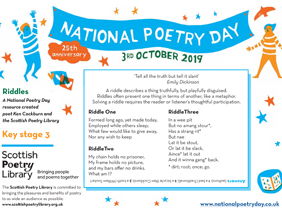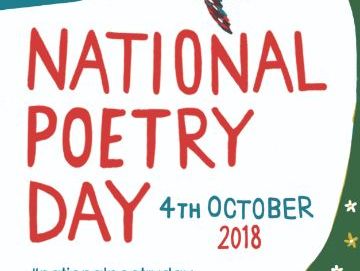111Uploads
54k+Views
27k+Downloads
All resources

Two Seasons: A National Poetry Day resource created by Morag Styles with The Poetry Archive
A comprehensive KS3/KS4 lesson plan designed to teach students how to respond to a poem, study the language of a poem, perform the poem, and then finally use that poem as inspiration to write something new. Includes a recording of Valerie Bloom reading her poem ‘Two Seasons’ as inspiration.

National Poetry Day 2019 Resource from the Scottish Poetry Library
Riddle writing poetry activities for KS3 students. Includes 3 riddles (and answers for teachers!) as well as detailed prompts for how to structure activities for different group sizes (class, group and individual work).

National Poetry Day 2021 The Poetry Archive Resource
A guide to exploring the theme of choice about our relationships with others in the context of troubling societal attitudes to inclusion and exclusion. For Key Stages 3-4 and featuring ‘Nothing Personal’ by John Mole.

National Poetry Day 2016 - "The Sea Says" - John Betjeman Prize - KS 1 -2
Forward Arts Foundation hope you make use of this fantastic FREE classroom resource for National Poetry Day 2016 on the theme of Messages.
The Betjeman Poetry Prize presents this activity called 'The Sea Says' for Key Stage 1 - 2 students. This is part of a wider collaborative effort with multiple partners, including the Scottish Poetry Library, the Poetry Society, The Emma Press, and the Poetry School.

Past Present Future: a resource created for National Poetry Day by poet Ken Cockburn and the Scottis
A complete KS2/KS3 lesson plan designed to teach students to write creatively in the past, present and future. Includes a copies of ‘Past’ and ‘Future’ by students from Leith Primary School in Edinburgh as inspiration.

I Will Be: A National Poetry Day resource created by First Story
A comprehensive lesson plan designed to get KS3 students to think about the use of different time frames in their creative writing, and then to write a poem based on past, present, and future changes. Includes a copy of Hafza Abdi’s poem ‘I Will Be’ as inspiration.

Time to Move: A National Poetry Day resource created by Apples and Snakes
Activities and lesson plans for KS3 students based on Thembe Mvula’s poem ‘Moving House’. Designed to teach students different ways of responding to a poem and how to then relate that poem to personal experiences they may have had. Includes poem and detailed instructions for a lesson plan.

Effecting change by inspiration A National Poetry Day resource created by Shakespeare Schools Founda
A comprehensive KS3/KS4 creative writing lesson plan using King Henry’s famous ‘Once more unto the breach’ speech from William Shakespeare’s ‘Henry V’ as inspiration. Includes extracts from the play, as well as an abridged version of the speech for younger students.

National Poetry Day 2019 Resource from Schofield & Sims
Classroom activities for KS1 and KS2 students based on Benjamin Zephaniah’s poem ‘Fair Play’. Designed to teach students about using humour and falsehoods in poetry to entertain their audience or readers. The activity encourages performance and group work.

National Poetry Day 2019 resource from Literature Wales
A fantastic Welsh language resource written by Casia Wiliam, former Bardd Plant Cyrmu for National Poetry Day 2019. Featuring a poem from Karen Owen.

National Poetry Day 2019 Resource from Betjeman Poetry Prize
A comprehensive poetry analysis lesson plan for KS2 English students that uses Charles Causley’s poem ‘The Owl Looked Out of the Ivy Bush’ to encourage students to think more deeply about poetic voices and the intention’s behind ‘nonsense poetry’. Includes a copy of the poem and suggested lesson structure.

National Poetry Day 2019 Resource from National Literacy Trust KS3
Activities and lesson plans for KS3 students based on Henry Normal’s poem ‘Three Lies and One Truth about the Moon’. Designed to explore the ‘fake news’ phenomena through poetry and performance. Includes poem and detailed instructions for a lesson plan.

National Poetry Day 2020 Seamus Heaney HomePlace Education Resource
This guide illustrates how to share your vision of your own special place. Designed for KS3/4/5 and featuring a poem by Seamus Heaney, this guide allows students to push their descriptive language skills in order to build an accurate picture of their vision for another person.

National Poetry Day 2020 CLPE Education Resource
A guide to outlining your poetic vision for our planet and the environment by Sue Hardy-Dawson. Designed for KS2, this guide includes a poem from Where the Zebra’s Go (Otter-Barry Books) as well as links to more helpful videos from Sue on writing poetry and free teaching resources from CLPE.

National Poetry Day 2020 John Hegley Education Resource
A short exercise for KS2 exploring poetry and visual art, from poet John Hegley. Featuring a poem from John and text by Clare Elstow, this guide suggests simple ways to use art to engage poetic responses from students. These activities form part of a larger resource pack produced by Tom MacAndrew, access details are included in this resource.

National Poetry Day 2020 The Poetry Archive Education Resource
A guide to exploring how using metaphors in poems can help to build pictures and images in our minds. Designed for KS1/2/3 and featuring an extract from ‘Granny Is’ by Valerie Bloom, use this resource structure to discuss how poems form images in our heads and how metaphors can be used to describe characters.

Change a memorable experience into a poem
A comprehensive creative writing lesson plan for KS3 students, designed to teach them the value of drawing from personal experiences when writing creatively. Includes a copy of Joshua Siegal’s poem ‘The Both of Us’ and further resources from the National Literary Trust as inspiration.
A National Poetry Day resource created by the National Literacy Trust.

Changing Seasons: A National Poetry Day resource created by the Betjeman Poetry Prize
A complete lesson plan for KS2/KS3 students, using a poem by a 13 year old winner of the Betjeman Poetry Prize as a way of encouraging students to think more deeply about language. Includes a copy of Rebecca MacLean’s poem.

National Poetry Day 2020 NLT KS3 Education Resource
Using a classic poem from Paul Laurence Dunbar (influential for poets such as Maya Angelou), this guide explores how to write a poem about freedom (or its opposite). Group activities designed for KS3, and featuring links and prompts for further exploration of Dunbar’s legacy and other poetry writing techniques.

National Poetry Day 2020 Scottish Poetry Library Education Resource
A guide to exploring limits through poetry, featuring the poem ‘Eye Chart’ by partially sighted poet Nuala Watt. Designed for KS3/4, this resource encourages students to examine their own strengths and weaknesses, and how these abilities make them feel, using this to create their own ‘Eye Chart’.




















